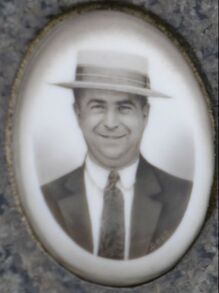Executive Director Brent D. Glass shares here his family connection to Sing Sing Prison.

My cousin Shari contacted me recently with interesting news. “Did you know,” she asked, “that a member of our family was incarcerated at Sing Sing Prison?” I had no idea. She sent a copy of the January 8, 1920 commutation for Matthew Gardner, who was convicted of third degree arson the year before. I checked the Find-A-Grave entry for great-uncle Matty to confirm that I might have a connection to the history of Sing Sing through this distant relative. Further research showed that yes indeed, Matthew Gardner was the brother of my maternal grandmother Irene Gardner. He died in 1930 at the age of 36. My mother was only three when he died and never mentioned him or his notorious past.
The events that led to his imprisonment were described in the April 1, 1919 edition of the Brooklyn Daily Times. On January 28, while he and his brother, Harry, went to a show with their wives, his paint and hardware store at 4170 Jamaica Avenue in Queens , New York (also his home address) caught fire and sustained extensive damage. An investigation quickly revealed that Matty offered to pay his partner $1000 to set the blaze in the hope of collecting $19,000 in insurance. He received a sentence of 3 to 6 years and arrived at Sing Sing Prison on April 3, 1919. In January 1920, Governor Al Smith commuted his sentence noting “that Gardner has a wife and a child twenty months old that need his assistance.”
What do we know about Matty Gardner’s relatively brief stay at Sing Sing? He lived in the old cellblock where the cells measured 3 feet 3 inches wide, 7 feet long and 6 feet 6 inches high. Without indoor plumbing, the men used the same bucket system that had been in place for nearly a century. A solitary light bulb swung overhead and on rare occasions a faint breeze came through the large vertical windows that had been carved out of the stone walls enclosing the cellblock. Did he buy cigarettes at the Mutual Welfare League store? Did he go to movies that were shown in the chapel? Did he meet Charles Chapin, the former newspaper editor convicted of murder, who later become known as the Rose Man of Sing Sing for creating the prison’s extensive gardens? Did he meet Owney Madden, nicknamed “The Killer,” who led New York’s Gopher Gang from Hell’s Kitchen? Did he avoid getting sick with the Spanish flu that had swept through Sing Sing in 1918 and 1919? Did he attend synagogue on High Holy days with the estimated 150 Jewish men incarcerated at that time?
Did he meet Lewis E. Lawes who began serving as Warden on January 1, 1920? Lawes became the most famous warden in America, leading a series of reforms to improve conditions and morale. Throughout his 21-year tenure, he secured funding for a major building campaign that modernized the facility. One reform he could not accomplish was to abolish the death penalty which he considered a useless and barbaric form of punishment. In spite of Lawes’s opposition more than 300 executions took place while he was warden, the first being Vincenzo Esposito on January 8, 1920, the same day that Governor Smith commuted Matthew Gardners’s sentence.
The events that led to his imprisonment were described in the April 1, 1919 edition of the Brooklyn Daily Times. On January 28, while he and his brother, Harry, went to a show with their wives, his paint and hardware store at 4170 Jamaica Avenue in Queens , New York (also his home address) caught fire and sustained extensive damage. An investigation quickly revealed that Matty offered to pay his partner $1000 to set the blaze in the hope of collecting $19,000 in insurance. He received a sentence of 3 to 6 years and arrived at Sing Sing Prison on April 3, 1919. In January 1920, Governor Al Smith commuted his sentence noting “that Gardner has a wife and a child twenty months old that need his assistance.”
What do we know about Matty Gardner’s relatively brief stay at Sing Sing? He lived in the old cellblock where the cells measured 3 feet 3 inches wide, 7 feet long and 6 feet 6 inches high. Without indoor plumbing, the men used the same bucket system that had been in place for nearly a century. A solitary light bulb swung overhead and on rare occasions a faint breeze came through the large vertical windows that had been carved out of the stone walls enclosing the cellblock. Did he buy cigarettes at the Mutual Welfare League store? Did he go to movies that were shown in the chapel? Did he meet Charles Chapin, the former newspaper editor convicted of murder, who later become known as the Rose Man of Sing Sing for creating the prison’s extensive gardens? Did he meet Owney Madden, nicknamed “The Killer,” who led New York’s Gopher Gang from Hell’s Kitchen? Did he avoid getting sick with the Spanish flu that had swept through Sing Sing in 1918 and 1919? Did he attend synagogue on High Holy days with the estimated 150 Jewish men incarcerated at that time?
Did he meet Lewis E. Lawes who began serving as Warden on January 1, 1920? Lawes became the most famous warden in America, leading a series of reforms to improve conditions and morale. Throughout his 21-year tenure, he secured funding for a major building campaign that modernized the facility. One reform he could not accomplish was to abolish the death penalty which he considered a useless and barbaric form of punishment. In spite of Lawes’s opposition more than 300 executions took place while he was warden, the first being Vincenzo Esposito on January 8, 1920, the same day that Governor Smith commuted Matthew Gardners’s sentence.

 RSS Feed
RSS Feed